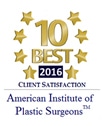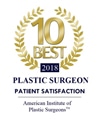Eyelid surgery, or blepharoplasty, also called an eyelid tuck is one of the most common cosmetic procedures performed in the United States. Blepharoplasty is a surgical procedure which removes fat, excess skin and muscle from the upper and lower eyelid, to reduce puffiness below the eyes. Eyelid surgery can decrease wrinkles formed around the eyelids, and correct drooping of the upper lids.
Candidates must be in good health, have no active diseases or serious, pre-existing medical conditions, and must have realistic expectations of the outcome of the surgery. Most individuals seeking blepharoplasty are in their mid-to-late thirties. If saggy or fatty eyelids are hereditary you may wish to undergo this procedure at an earlier age. In extreme cases, where patients find that their sight has become impaired due to the drooping of the upper lids, surgery may improve vision.
NOTE: You may not be a candidate for surgery if you smoke, have recently quit smoking, or if you are exposed to second-hand smoke. Primary and secondary smoking decreases blood flow to the body’s tissues. This can result in prolonged wound healing, skin loss, infection, increased scarring, and a number of other complications depending on the kind of procedure performed.
An incision is made along the lash line in the lower lid, and/or on the upper portion of the upper lid and smile creases. Excess fat, muscle and skin are removed. Fine sutures are then used to close the incision. Sutures will usually be removed within one week after the procedure. If you only have pockets of fat beneath your lower eyelids, and do not need to have any excess skin removed, your surgeon may recommend “transconjunctival” eyelid surgery. In this procedure, the incision is made on the inside of your lower eyelid, which leaves no visible scar. Transconjunctival blepharoplasty will not tighten skin, but will reduce puffiness in the lower eyelid region.
Some patients choose to have laser resurfacing or a chemical peel in addition to the blepharoplasty. This may minimize fine wrinkles near the eye. A forehead lift may correct sagging or abnormally positioned eyebrows.
First, schedule a personal consultation. Communication is vital in establishing realistic expectations and reaching your goals. You will have the opportunity to discuss your goals and the results you’d like to achieve. Dr. Roesner will work with you to reach an understanding about what you can expect from this procedure and what long-term benefits you will experience. Every patient is different, and together, you will choose the surgical technique and treatment plan that is right for you.
You will be given specific instructions on how to prepare for your surgery. A pre-operative information packet will be provided that explains everything you should do and know before your surgery date. Your surgeon will instruct you on how to prepare for surgery, including guidelines on eating and drinking, smoking, and which vitamins and medications should be taken or avoided. You should arrange for someone to drive you home after your surgery, whether your surgery is done on an outpatient or inpatient basis. You may also want to make arrangements for someone to help you out for a day or two after you leave the hospital.
Several options exist for where breast augmentations are done. Dr. Roesner has surgical privileges at St. Anthony Hospital, Rose Medical Center as well as North Suburban Medical Center. The majority of these procedures are completed on an out-patient basis.
You’ll remain comfortable throughout the entire procedure. In most cases, general anesthetic is used so that you will sleep throughout the procedure; although local anesthesia with intravenous sedation is also an option for some patients.
It is very important that you follow your surgeon’s instructions. This will promote healing and improve progress towards your new physical appearance. Also, it is important that you attend all scheduled follow-up appointments so Dr. Roesner can assess your long-term results and answer any questions or concerns you may have.





I had the Laser Genesis treatment. The procedure was comfortable on my skin and without any downtime for noticeable results! I would highly recommend this procedure. The entire office is great to work with and an awesome team. L.T., Lafayette
Amazing staff , ready to answer all my questions , I felt very comfortable talking to them ,specially Leah , she made feel very secure about the procedures and totally happy of have chosen them. Zuleyma F.
Fantastic! I have had multiple procedures done by almost everyone in the office . I recommend this place to everyone! Love this place! Lindsay W.
